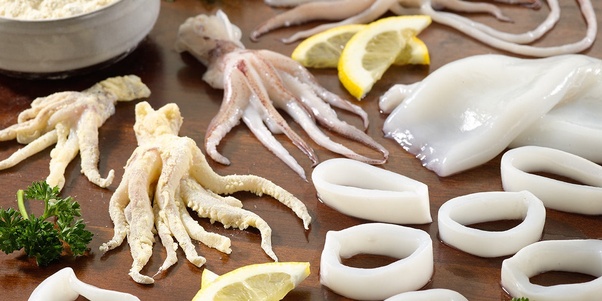What is Calamari? A Comprehensive Guide
Introduction
Calamari, also known as squid, is a type of marine animal that belongs to the class Cephalopoda. It is a popular seafood item consumed worldwide due to its unique taste and nutritional benefits. In this article, we will delve into the world of calamari, exploring its biology, culinary uses, and cultural significance. We will also provide a detailed FAQ section to address common questions about calamari.
Biology of Calamari
Calamari, scientifically known as Loligo vulgaris, is a type of squid that belongs to the family Loliginidae. It is found in temperate and tropical waters around the world, from the Atlantic Ocean to the Pacific Ocean. Calamari are characterized by their soft bodies, large eyes, and eight arms.
Physical Characteristics
- Body: Calamari have a soft, gelatinous body that is typically 10 to 20 inches (25 to 50 cm) long. They have a distinctive head with a pair of large eyes and a beak-like mouth.
- Arms: They have eight arms, which are used for movement and catching prey.
- Mantle: The mantle is the main body of the squid, which contains the organs and tissues necessary for life.
- Siphon: The siphon is a muscular tube that helps the squid move through the water by expelling water.
Life Cycle
Calamari have a complex life cycle that involves several stages:
- Egg Stage: Female calamari lay eggs in a gelatinous mass, which are then fertilized by the male.
- Paralarva Stage: The eggs hatch into paralarvae, which are small, transparent squid that feed on plankton.
- Juvenile Stage: As the paralarvae grow, they develop into juveniles, which are larger and more mobile.
- Adult Stage: Once they reach maturity, calamari become adults and are capable of reproducing.
Diet
Calamari are carnivores and feed on a variety of prey, including:
- Plankton: Small organisms such as copepods, krill, and fish larvae.
- Fish: Small fish like anchovies and sardines.
- Invertebrates: Shrimp, crabs, and other invertebrates.
Habitat
Calamari are found in a variety of marine habitats, including:
- Shallow Waters: They are often found in shallow waters near the coast, where they can feed on plankton and other small organisms.
- Deep Waters: Some species of calamari can be found in deep waters, where they feed on larger prey.
Reproduction
Calamari reproduce by releasing sperm and eggs into the water. The eggs are fertilized externally, and the larvae develop in the water column.
Anatomy
Calamari have several unique anatomical features, including:
- Beak: The beak is used for catching and eating prey.
- Gills: They have gills for respiration.
- Squid Ink: Calamari have a dark, inky substance that they use for defense and to confuse predators.
Defense Mechanisms
Calamari have several defense mechanisms to protect themselves from predators:
- Ink: They can release a cloud of dark ink to confuse predators.
- Jets: They can use their siphon to shoot water jets to propel themselves away from predators.
- Color Change: They can change color to blend in with their surroundings.
Conservation Status
Calamari are generally considered to be a sustainable seafood option. However, overfishing and pollution can affect their populations. Some species of calamari are protected under international conservation laws.
Culinary Uses
Calamari is a popular seafood item consumed worldwide due to its unique taste and texture. It is often served as a fried or grilled appetizer, and can be found in various cuisines, including Italian, Greek, and Asian.
Nutritional Benefits
Calamari is a nutritious food that provides several health benefits:
- Protein: It is a rich source of protein, which is essential for muscle growth and repair.
- Omega-3 Fatty Acids: Calamari contains omega-3 fatty acids, which are beneficial for heart health and brain function.
- Vitamins and Minerals: It is also a good source of vitamins and minerals like vitamin B12, iron, and selenium.
Cultural Significance
Calamari has cultural significance in many parts of the world, including:
- Italian Cuisine: In Italy, calamari is a staple ingredient in many dishes, including fried calamari and calamari alla griglia.
- Greek Cuisine: In Greece, calamari is often served as a grilled appetizer or in soups.
- Asian Cuisine: In Asian countries like Japan and Korea, calamari is used in various dishes, including sushi and stir-fries.
FAQs
Q: What is calamari?
A: Calamari is a type of squid that belongs to the family Loliginidae. It is a popular seafood item consumed worldwide due to its unique taste and nutritional benefits.
Q: How do calamari reproduce?
A: Calamari reproduce by releasing sperm and eggs into the water. The eggs are fertilized externally, and the larvae develop in the water column.
Q: What do calamari eat?
A: Calamari are carnivores and feed on a variety of prey, including plankton, fish, and invertebrates.
Q: Where can I find calamari?
A: Calamari are found in temperate and tropical waters around the world, from the Atlantic Ocean to the Pacific Ocean.
Q: Is calamari sustainable?
A: Calamari is generally considered to be a sustainable seafood option. However, overfishing and pollution can affect their populations.
Q: How do I cook calamari?
A: Calamari can be cooked in various ways, including frying, grilling, and baking. It is often served as a fried or grilled appetizer.
Q: What are the nutritional benefits of calamari?
A: Calamari is a nutritious food that provides several health benefits, including protein, omega-3 fatty acids, and vitamins and minerals.
Q: What is the cultural significance of calamari?
A: Calamari has cultural significance in many parts of the world, including Italy, Greece, and Asian countries like Japan and Korea.
Table of Information
| Characteristic | Description |
|---|---|
| Body | Soft, gelatinous body, typically 10 to 20 inches long. |
| Arms | Eight arms used for movement and catching prey. |
| Mantle | Main body of the squid, containing organs and tissues. |
| Siphon | Muscular tube used for movement and expelling water. |
| Beak | Used for catching and eating prey. |
| Gills | Used for respiration. |
| Squid Ink | Dark, inky substance used for defense and to confuse predators. |
| Habitat | Found in shallow and deep waters, near the coast. |
| Diet | Carnivorous, feeding on plankton, fish, and invertebrates. |
| Reproduction | Releases sperm and eggs into the water, fertilized externally. |
| Defense Mechanisms | Uses ink, jets, and color change to protect itself from predators. |
| Conservation Status | Generally considered sustainable, but overfishing and pollution can affect populations. |
| Culinary Uses | Fried or grilled as an appetizer, used in various cuisines. |
| Nutritional Benefits | Rich in protein, omega-3 fatty acids, and vitamins and minerals. |
| Cultural Significance | Significant in Italian, Greek, and Asian cuisines. |
Additional Resources
- Wikipedia: Squid
- National Oceanic and Atmospheric Administration (NOAA): Squid and Octopus
This comprehensive guide provides an in-depth look at calamari, covering its biology, culinary uses, and cultural significance. The FAQ section addresses common questions about calamari, and the table of information summarizes key characteristics.



